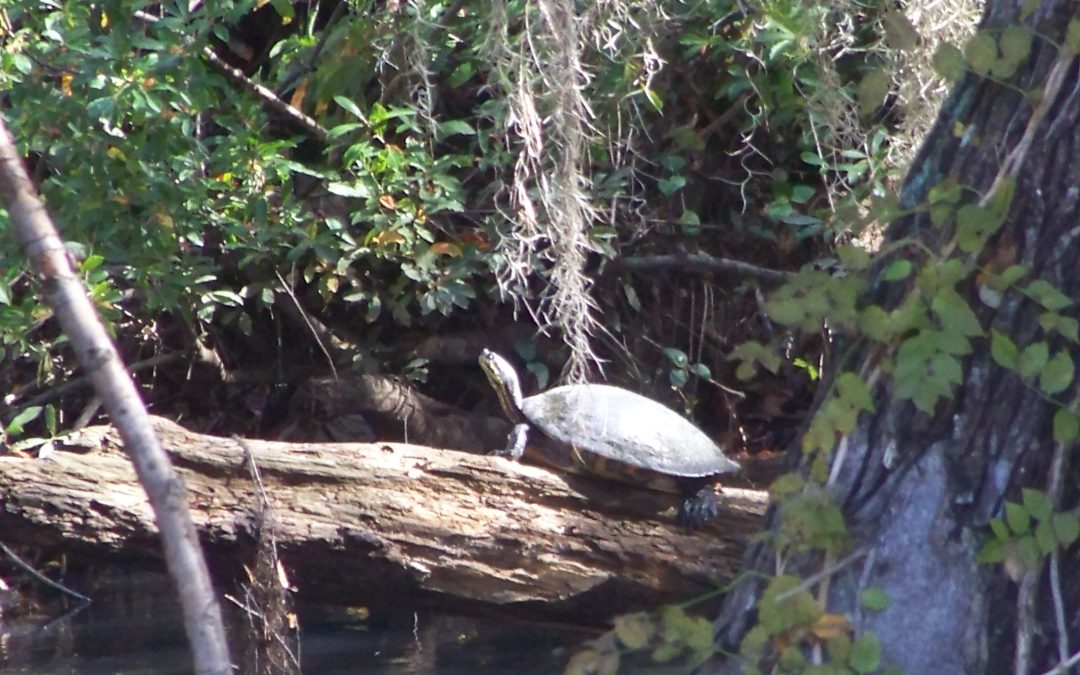
by Rick O'Connor | Jul 2, 2020
Cooters are one of the more commonly seen turtles when visiting a freshwater system. They are relatively large for a freshwater turtle (with a carapace about 13 inches long) and are often seen basking on logs, rocks, aerator pumps, you name it – and often in high numbers while doing so. They spook easy and usually leap into the water long before you reach them. But because of their beautiful smooth shells and large size, they can be seen from a distance – looking like wet rocks on a tree limb.
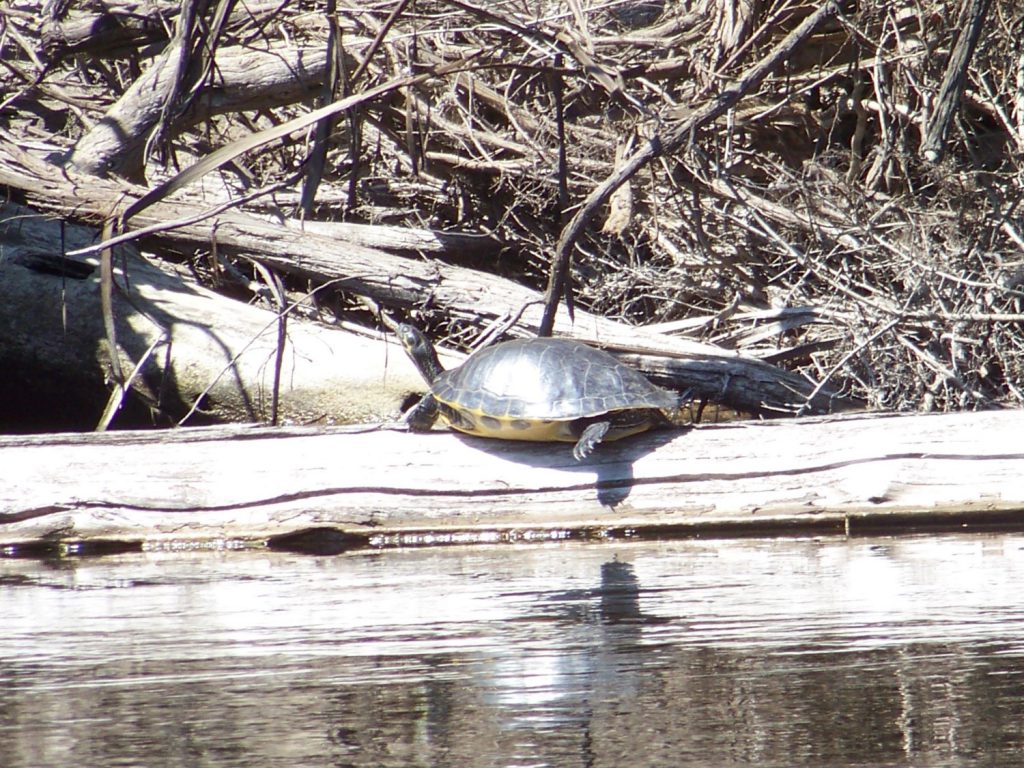
A “River Cooter” seen basking on a log in Blackwater River.
Photo: Molly O’Connor
They are in the genus Pseudemys (same as the Florida red-bellied turtles) and this genus is found throughout the southeastern United States. However, from there the breakdown of species becomes a bit challenging. There has been much debate how many species there really area, and how many are subspecies of those species. There are two distinct species for sure – the “River Cooter” (Pseudemys concinna) and the “Pond Cooter” (Pseudemys floridana). From here is gets a bit weird.
The “River Cooters” are just that – friends of rivers. They like those with a bit of a current, sand/gravel bottoms, basking spots, and grasses to eat. They have been found in estuaries, even with barnacles growing on them, so they have some tolerance for saltwater. River cooters can be distinguished from their “Pond Cooter” cousins in having a more aerodynamic shell (presumably for their habit of living in faster flowing rivers) with yellow-orange markings that form concentric rings on each scute (scale) of the carapace. Some of these seem to form a backwards “C”. Their plastron is yellow-orange but will have black markings along the margins of each scute.
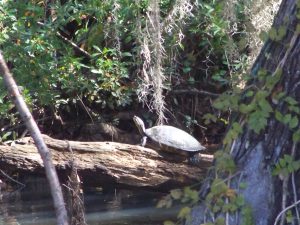
This river cooter is basking on a log on the heads waters of the Choctawhatchee River in Alabama.
Photo: Molly O’Connor
The “Suwannee Cooter” is believed to be a subspecies (Pseudemys concinna suwanniensis) found in tannic rivers from the Ochlockonee just west of Tallahassee south to the Tampa Bay region. It has only been found in rivers that flow into the Gulf of Mexico. A couple of records have been found in rivers flowing towards the Atlantic, but it is believed these were relocated by humans.
The “Eastern River Cooter” is found from the Ochlockonee River west to Mobile Bay – possibly as far as Louisiana. There has been a suggestion that the one west of Mobile Bay is the “Mobile Cooter” (Pseudemys concinna mobilensis) but the naming of this group, again, has been a bit crazy.
As mentioned, “Pond Cooters” are fans of slow-moving waters with muddy bottoms. Unlike river cooters, pond cooters will travel over land other than to lay eggs. Many of their “pond” selections dry up and they must find new habitat. Like river cooters, pond cooters feed on vegetation so aquatic plants are must and they also like to bask in the sun on logs with many cooters basking at once.
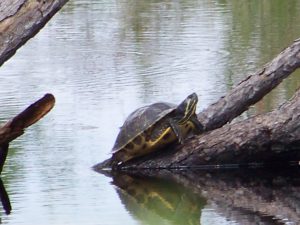
A pond cooter in a canal within the Gulf Islands National Seashore.
Photo: Molly O’Connor
Physically they differ from river cooters in having a slightly domed shell near the head end. The yellow markings are not concentric, but rather are in straight lines and their plastrons are an immaculate beautiful yellow – with no markings on the margins. They do however have black circles on the bottom margins of their carapace. These are usually round with a small yellow spot in the center – resembling an “o”.
There is believed to be two subspecies of this group. Pseudemys floridana floridiana (the “Florida Cooter”) and Pseudemys floridana peninuslaris (the “Peninsula Cooter”). Told you it was all weird. The Florida cooter is found in the Florida panhandle and the Peninsula Cooter has been found all the way to the Florida Keys – though it does not seem to be common in the Everglades.
Add to the quagmire of species identification – there is hybridization between not only the types of pond and river cooters – but BETWEEN the pond and river cooters. So, if you live in the eastern panhandle where all of these seem to converge – just call them “cooters”!
They have an interesting nesting habit. When the females approach an open sunny sandy spot, she will dig a hole to lay about 20 eggs, but she will also dig two “satellite” nests on either side – and maybe place an egg or two in there. It is quite understood why they do this, but they do. They also may come to the beach up to five times in one year to lay eggs.
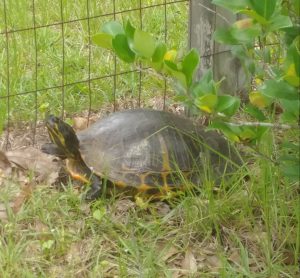
A pond cooter digging a nest on someone’s property.
Photo: Deb Mozert
Because of their high numbers and large size, this has been a favorite food item for humans for quite some time. Due to this, and the practice of shooting them off their basking spots, and alterations of river systems lower the habitat quality for the river cooters, their numbers have declined. The Suwannee Cooter in particular has been hard hit and is a species of concern. Due to this it no longer allowed to harvest them (or their eggs) from the wild. Because it is so hard to tell the Suwannee from other species/subspecies of cooters – ALL cooters are now protected by the Florida Fish and Wildlife Conservation Commission.
Another note – they do not eat fish. The young will eat worms and insects, but the adults are strictly herbivores. Many pond owners want to shoot them thinking they are eating the stocked fish by the landowner. They will not eat the fish – you are fine.
I think these are amazingly beautiful animals to see glimmering in the sunny on their basking logs as you explore our local rivers and wetlands. I hope you find them just as cool and appreciate them.
Resources:
Buhlman, K., T. Tuberville, W. Gibbons. 2008. Turtles of the Southeast. University of Georgia Press, Athens GA. 252 pp.
Florida Fish and Wildlife Conservation Commission. Freshwater Turtles https://myfwc.com/wildlifehabitats/wildlife/freshwater-turtles/.
Meylan, P.A. (Ed.). 2006. Biology and Conservation of Florida Turtles. Chelonian Research Monographs No.3, 376 pp.
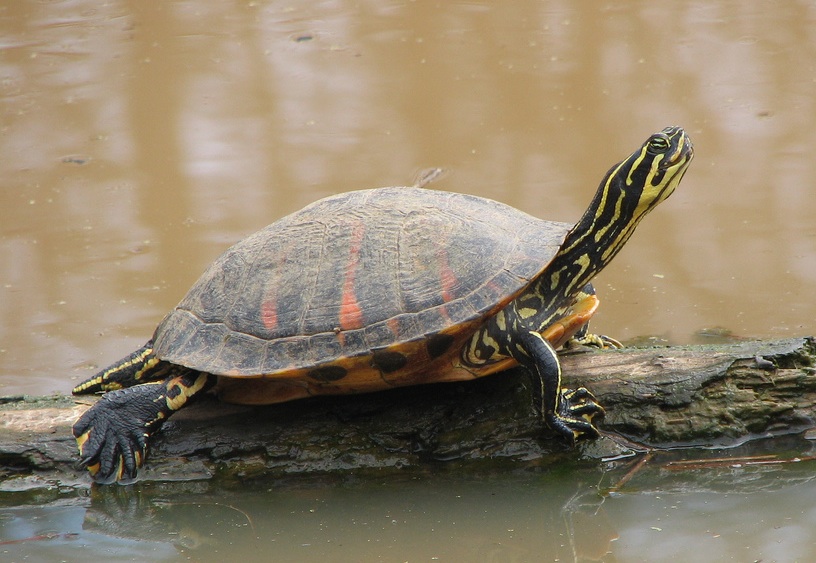
by Rick O'Connor | Jun 18, 2020
Cooters are common freshwater turtles throughout the state of Florida. There are currently three species listed: Pseudemys concinna – commonly known as the “river cooter”, Pseudemys floridana – referred to as the “Florida cooter”, and Pseudemys nelsoni – the “Florida red-bellied turtle”. It is this third species we will focus on in this article.
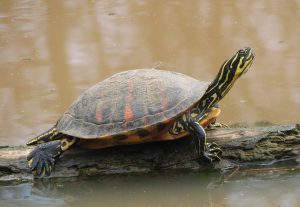
The wide red markings contrasting with the yellow striping on the body makes this a beautiful turtle.
Photo: Wikipedia
When you pick up a Florida red-bellied turtle you will see why it gets that name. The belly, or plastron, is a reddish-orange color. You will also see red coloration of the large broad stripes on the carapace and small red spots on the marginal scutes of the carapace. Contrasting this with the brilliant yellow stripes of the head and legs – this a beautiful turtle.
Like other cooters, they are big pond turtles as well – reaching carapace lengths up to 15 inches. They have high domed shells, compared to the other two cooters, and the shell is much thicker. This is probably due to the fact that the Florida red-bellied lives with the American alligator. They are known to even lay their eggs in an alligator nest! Other features that separate them from their cousins is the presence of yellow striping between the eyes resembling an “arrow”, and a deep notch in the upper lip.
The distribution of this turtle is interesting. They are definitely found, and are common, in the peninsular part of the state – ranging from the Okefenokee Swamp in southern Georgia to the Florida Everglades. Here they most frequently found in slow moving backwaters of rivers and springs, lakes, ponds, marshes, sinkholes, and even canals along highways. However, there have been verified reports of this animal in the Apalachicola River basin. Several have been found on St. Vincent island between Apalachicola and Port St. Joe. One was photographed within the city limits of Apalachicola and a few in the Dead Lake region of the Chipola River feeding into the Apalachicola. There is about 100 miles between the Suwannee and Apalachicola River systems – how did they make this trip?
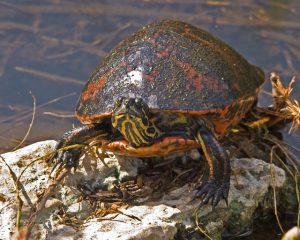
The red coloration of the common Florida Red-bellied turtle.
Photo: Flickr
One idea is that someone brought them there a long time ago – and they have survived. A long time meaning prior to the 1950s. Another thought is that the historic range may have included much of the Florida panhandle before sea level changed. There is an Alabama Red-bellied turtle (Pseudemys alabamensis) that inhabits the marshes of the Mobile Bay delta. The habitat here is very similar to the marshes of the Everglades, and the Apalachicola region. The Alabama red-bellied has very similar characteristics to the Florida red-bellied (arrow stripes and notch in upper lip). There are no records of the Alabama Red-bellied in the delta of the Escambia River, and no record of either species in the Choctawhatchee delta. So, who knows??? To add to the story – one Florida Red-bellied was verified in the Wacissa River – which lies about halfway between the Suwannee and the Apalachicola rivers. Yep… interesting mystery.
Like other cooters, the females are larger than the males and the males have elongated fingernails on their forelimbs to entice the female’s interest in mating. These long fingernails are also found on the sliders (Trachemys). In Florida, the red-bellied appears to breed year-round. Even though nesting is typical of other turtles (spring and summer) they may lay eggs year-round as well.
The females will approach the beach multiple times during the nesting season and lay anywhere from 6-30 eggs in the nest. Sex determination of the young is determined by the temperature within the nest, warmer eggs become females. The Florida red-bellied has an unusual habit of laying some of their eggs in alligator nests. Though alligators can be considered a predator of this turtle, sneaking in and laying eggs will provide protection – for unlike turtles, alligators guard their nests from predators. It is believed the thicker shell of the Florida red-bellied is to protect it from this possible adversary.
That said, they do have their predators. Like all young turtles there are a variety of birds, fish, mammals, and reptiles that feed on them. Red-bellies are plant eaters – feeding on a variety of aquatic plants including the invasive water hyacinth and hydrilla.
These are common basking turtles throughout much of peninsular Florida and visitors should easily get a glimpse of them while they are here. How far into the Florida panhandle they range is still a mystery – but an interesting one. I hope one day you get to see this beautiful turtle.
References
Buhlmann, K., T. Tuberville, W. Gibbons. 2008. Turtles of the Southeast. University of Georgia press, Athens GA. 251 pp.
Meylan, P.A. (Ed.) 2006. Biology and Conservation of Florida Turtles. Chelonian Research Monographs No.3. 376pp.
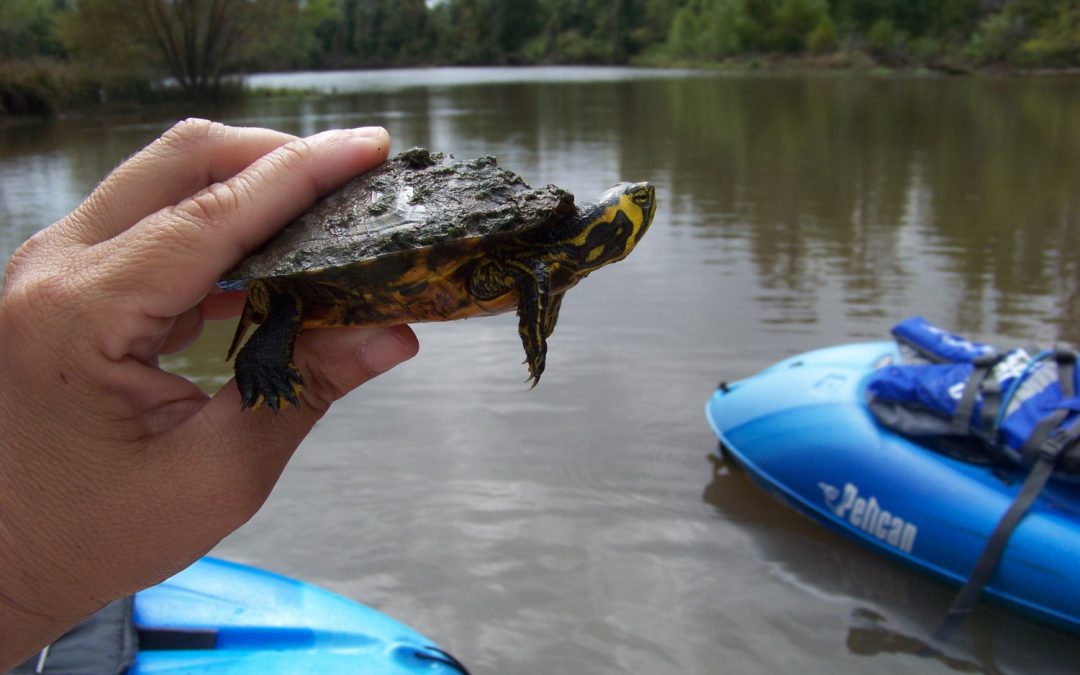
by Rick O'Connor | Jun 2, 2020
They call it a slider…
Maybe because they slide off a tree trunks into the water? Honestly, I really don’t know – but sliders it is.
They are very common pond turtles all across the eastern and mid-west portions of the United States reaching as far west as New Mexico. Within this range there are two subspecies: The Yellow-bellied Slider (Trachemys scripta scripta) and the Red-Eared Slider (Trachemys scripta elegans). In Florida, only the yellow-bellied is native and it is only found in northern Florida. The red-eared slider is found throughout our state but is non-native and considered by some to be invasive.
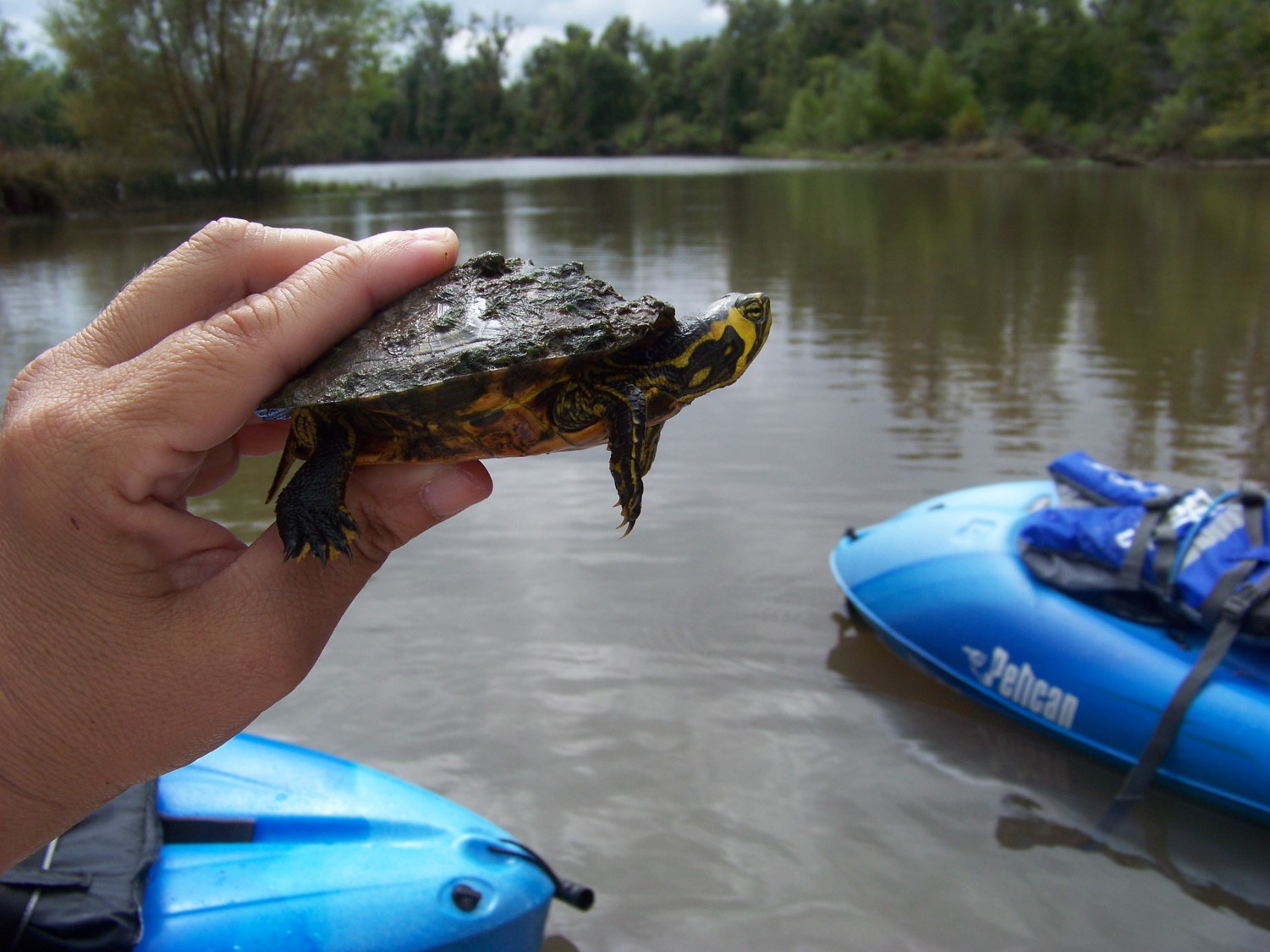
The distinct yellow patch on the cheek helps identify the yellow-bellied slider.
Photo: Molly O’Connor
Sliders are mid-sized emydid turtles and found in almost any type of water body. They prefer water bodies with slow currents, lots of sun, and plants – but have been found in retention ponds, rivers, golf courses, you name it. The shell (carapace) is rounder than the other common pond turtle called the cooter. Their shells are usually between 3 – 11 inches long, with females being larger. They have a slight keel running down the middle of their shell and the back margin is slightly “toothed” or serrated. The “belly” shell (or plastron) is usually yellow (source of their common name) as juveniles and forms dark blotches with age. The body is a dark green or black color with fine yellow stripes. The yellow-bellied slider will have a large yellow patch in the cheek area, which is easy to see from a distance. The red-eared has a small red patch behind and above the ear area. The carapace will be green as a juvenile and become darker as an adult. There will be beautiful patterns of yellow in the shell that fade with time. Older sliders will have faded shells all together and the yellow markings on the head and body will fade as well. They call this a melanistic phase.
Sliders are most active during daylight hours and are known to spend some time on land. They can be seen frequently basking on tree stumps and logs and can be aggressive towards each other. Red-eared sliders are known to be aggressive in aquaria.
They are omnivores. Young sliders are carnivorous feeding on small worms and insects. The adults switch to plant diet. Many sliders are shot, or destroyed in other ways, by locals thinking they will eat all the fish in their ponds – they will not.
Males are usually smaller, typically not having carapace lengths greater than 10 inches. Mature males will have extended “fingernails” or claws on their forelimbs. Mating takes place in the water and females have been known to travel up to 1500 feet from the water seeking good nesting habitat. Once found, they may dig a couple of “trial” nests before laying 5-20 eggs in a real one. They lay up to 3 active nests/nesting female/year.
Numerous animals will consume the turtle eggs and hatchlings. Adults have been consumed by alligators, minks, raccoons, otters, and gars.
Within their range, they are considered common but are still protected by Florida law. You may not have more than one slider/person/day from the wild and cannot use for commercial purposes. The red-eared slider is considered non-native and it is illegal to release non-natives into the local environment.
These are beautiful turtles and we hope that if you have not already seen one, you will get to soon.
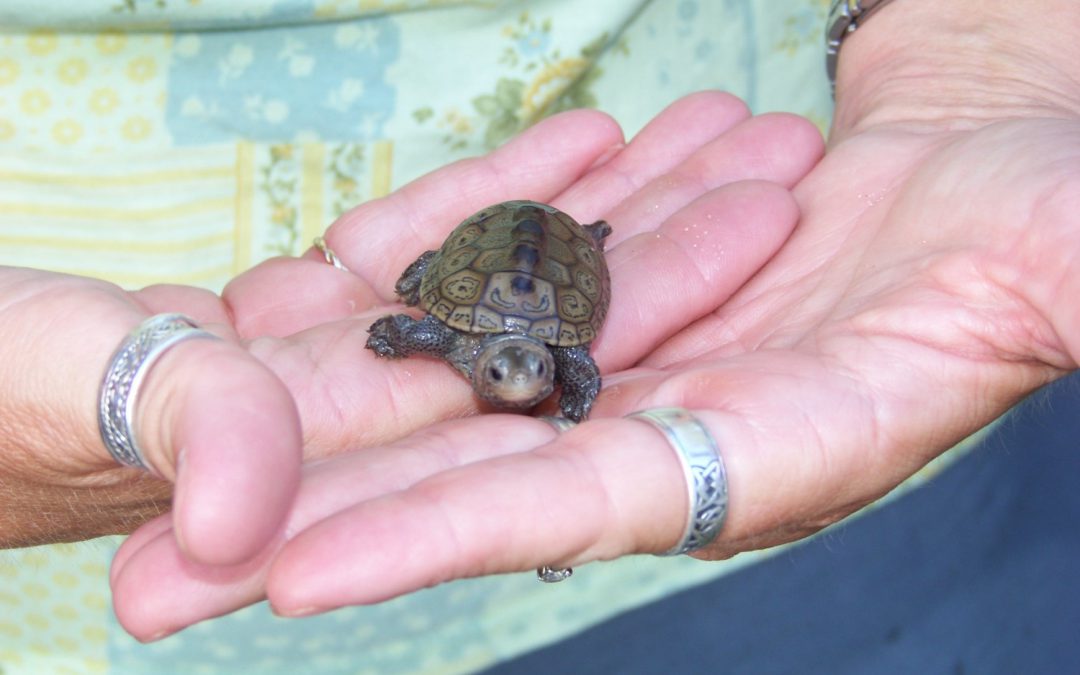
by Rick O'Connor | May 17, 2020
In my time educating the public about Florida turtles I have found that most Floridians have not heard of diamondback terrapins. They have heard of, and seen turtles, but are not sure what the names of the different species are and are not familiar with the term terrapin at all. Which brings up the question – what is the different between a turtle, a tortoise, and a terrapin?
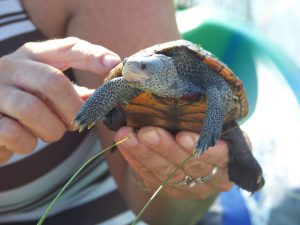
The light colored skin and dark markings are pretty unique to the terrapin.
Photo: Molly O’Connor
Honestly, they are cultural terms and not “biological” descriptions. We associate the term “tortoise” with a land turtle – and this is true – yet we call the box turtle a “turtle” – which is fine. In Great Britain they call almost everything a “terrapin”. The term “terrapin” is a Delaware Indian term meaning “edible turtle”. Most turtles are edible, but this term stuck to a group of brackish water turtles in the Chesapeake area near Delaware we now call “terrapins”.
In the Mid-Atlantic states, terrapins are more known than they are here – and they appear to be more abundant. They are the mascot of the University of Maryland, and the official state reptile there. “Turtle Soup”, a popular cultural dish in the Chesapeake, is made with terrapins. It was served as part of the state dinner when Abraham Lincoln was president – considering it a classic “American” dish. They were harvested by walking through the marshes with a burlap sack and a gig. A sack could bring a harvester about $10, but when the popularity of the dish increased, hand harvesting could not keep up with demand and terrapin farms began. I know there were terrapin farms in the Carolinas, but there was one near Mobile, Alabama as well. Apparently, terrapins existed outside of the Chesapeake – and that brings us back to Florida… we have them too!
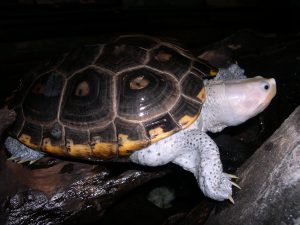
Ornate Diamondback Terrapins Depend on Coastal Marshes and Sea Grass Habitats
There are seven subspecies of this brackish water turtle. They range from Massachusetts to Texas. It is the only resident brackish water species, spending its whole life in salt marshes (or mangroves in south Florida). Florida has five of the seven subspecies, and three of the seven ONLY live in Florida – yet most of us do not know the animal exist.
Very few researchers worked with terrapins in this state – there was virtually nothing known about them in panhandle. In 2005 I began to survey panhandle marshes to see if terrapins existed here. I grew up in the panhandle, and like so many others, had never seen or heard of one. I asked local fishermen who use to gillnet the marshes back in the 1950s and 1960s (when it was allowed) if they were aware of this this turtle. I asked them “did you ever capture a terrapin?” They did not know what I was talking about. And then I showed them a picture… “OH… yea, we did catch these once in a while – what are they called again? Terrapins?”. This was a game changer for me in terrapin education – show them a terrapin and ask if they have ever seen a turtle that looks like this.
The response was still “what is that? It’s beautiful!”… and they are. Terrapins have light colored skin with dark specks or bars – a really pretty cool looking turtle. Oh, and they are in the panhandle, just not in big numbers – or, at least, we have not found them in big numbers 😊.
These brackish water turtles spend their entire lives in a marsh system feeding on mollusk and crustaceans. Like map turtles (their nearest cousins), the females are larger with wide heads for crushing the shells of their prey. They are considered an important member of the ecosystem in that the reduction of terrapins can cause an increase in the marsh periwinkle (a popular snail food) who would in turn stop feeding on leaf litter and attack the live plants themselves – threatening the existence of the marsh. So, they are important predators on marsh grazers. Not having a lot of trees in a salt marsh, you do not see them basking on logs as you do with other riverine turtles. They do, however, exit the water and bury in the mud/sand for long periods to bask.
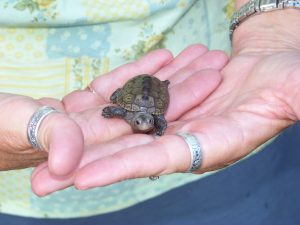
A baby terrapin.
Photo: Molly O’Connor
After mating, the females usually leave the marsh for the open estuary, swim along the shorelines looking for high/dry ground for nesting. More often than not, these are sandy beaches – but they have been known to dig nest in crushed shell mounds, dredge spoil islands, along highways, backyards, and even runways of airports – wherever “high and dry” can be found in a marsh. In Louisiana a lady found one roaming around inside her outdoor shower – good luck nesting there!
The females lay about 10 eggs in a clutch and will lay more than one clutch each year. Baby terrapins are one of the coolest looking turtles you will see. They emerge from the nest in late summer and fall, hiding in the wrack debris along the shoreline. It is believed they actually have a more terrestrial life early on before entering the water and living out their lives in the marsh.
The popularity of turtle soup has waned since the Civil War, as have the wild harvest and aquaculture projects. However, the turtle is still under tremendous pressure from humans. We began using wired crab traps in the 1950s and terrapins have a habit of swimming into these, where they drown. The problem is not that large in Florida, but in the Chesapeake, they have found as many as 40 terrapins in one crab trap! Most of these are “ghost crab traps” – ones that “got away” from the owner but are still harvesting marine live – including crabs. One paper indicated that in the early part of the 21st century, in one year in the Chesapeake, over 900,000 blue crabs died in ghost crab traps – a commercial value of about $300,000. So, the ghost crab trap is a problem whether it kills terrapins, redfish, flounder, or blue crab. Today, many crab traps have biodegradable panels so that if the trap “gets away” it will eventually breakdown and not capture organisms like terrapins. In the Chesapeake many states require crab traps to have a By-Catch Reduction Device (BRD) to keep terrapins out – but allow crabs in. They are not required in Florida, however FWC will provide them for free if you are interested. I have some in my office in Pensacola and more than willing to give them to you. FWC also hosts crab trap removal programs, and I encourage you to participate in these.
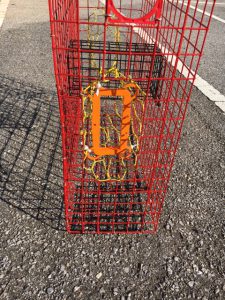
This orange plastic rectangle is a Bycatch Reduction Device (BRD) used to keep terrapins out of crab traps – but not crabs.
Photo: Rick O’Connor
A bigger issue for Florida is the land-based predators. As we moved closer and closer to the salt marshes, we built bridges and roads that allowed land-based predators to reach the nesting beaches they previously did not have access to. Raccoons in particular are a big problem, depredating as many as 90% of the terrapin nests. Poaching for the pet trade is rising and FWC is working on this. Several major arrests have been made in Florida in recent years. It is illegal to sell Florida turtles, so do not buy them if you see them being sold somewhere. Report the activity to FWC.
Due to all of this, terrapins afford some form of protection in each of the coastal states where they exist. Some list them as “endangered” or “threatened”. In Florida, they do not have this label, but they are protected by FWC. No one is allowed to have more than two in their possession, and you are not allowed to have any eggs.
It is an amazing turtle. I currently conduct a citizen science program monitoring them in the western panhandle. I have a lot of eager volunteers wanting to see their first one in the wild. I hope they do soon. I hope they hang around long enough for everyone to see one in the wild.
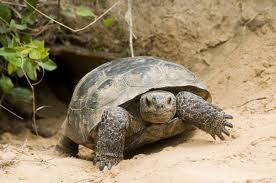
by Carrie Stevenson | May 8, 2020
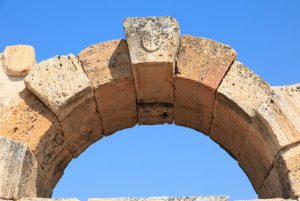
In ecology, a “keystone” species is as crucial to an ecosystem as the central stone in this arch.
In architecture, a “keystone” is the top, central block in an arch structure, the one that holds the entire building up. Without it, the bricks around it collapse. With it, there is nothing stronger.
So, when you hear an animal referred to as a “keystone” species, it should get your attention—especially when that species is listed as threatened by state and federal wildlife agencies. In northwest Florida, one of the species upon which the entire longleaf ecosystem is built is the humble gopher tortoise (Gopherus polyphemus).
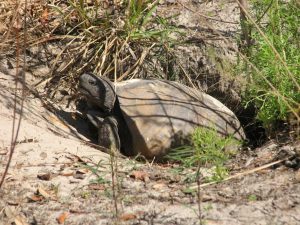
Gopher tortoises are long-lived, protected by their thick shells and deep burrows. Photo credit: Carrie Stevenson, UF IFAS Extension
Once hunted for food and currently in competition with humans for buildable land, this long-lived reptile is an architect in its own right. The tortoises are called “gophers” because of their tunnel building and burrow construction expertise. The tortoises spend about 80% of their time near their burrows, of which they have multiple over their lifetimes. Being a cold-blooded reptile, the burrows allow the tortoises a place to live in the temperature-regulated soil.
The average adult gopher tortoise is about 9-11 inches long, although they can be larger. They have thick feet resembling those of an elephant, and scaly front legs used for digging and burrowing. They are tan, brown, or gray, and live in dry, sandy, upland habitats. Their propensity for dry forestland is typically why their populations are in peril, as this is also the best land for building and development.
The average gopher tortoise’s burrow is 6.5 feet deep and 15-40 feet long, and provides habitat for 350 other species! Those commensal species that share its burrow are mostly invertebrates, but at least 50 are larger backboned species like frogs, snakes, rabbits, and burrowing owls. During forest fires, there are stories of multiple species—from deer and snakes and turtles—calling a truce and hiding in the burrows together until the flames blow over.

Gopher tortoises are nesting right now–be sure to observe from a distance!
Right now—from May to July—is nesting season for gopher tortoises. They lay eggs in the soft sand of their burrow apron, which is the triangular spread of loose sand at the opening of the burrow. Eggs incubate all summer and emerge between August and November. The newly hatched tortoises can expect to live 40 to 60 years in the wild. They live on a variety of grasses and low-growing plants native to longleaf pine, oak forests, and coastal dunes, including wiregrass and gopher apple. They are adapted to routine fires, as they are safe in their burrows and the new growth after a burn provides an abundance of their grassy food sources.
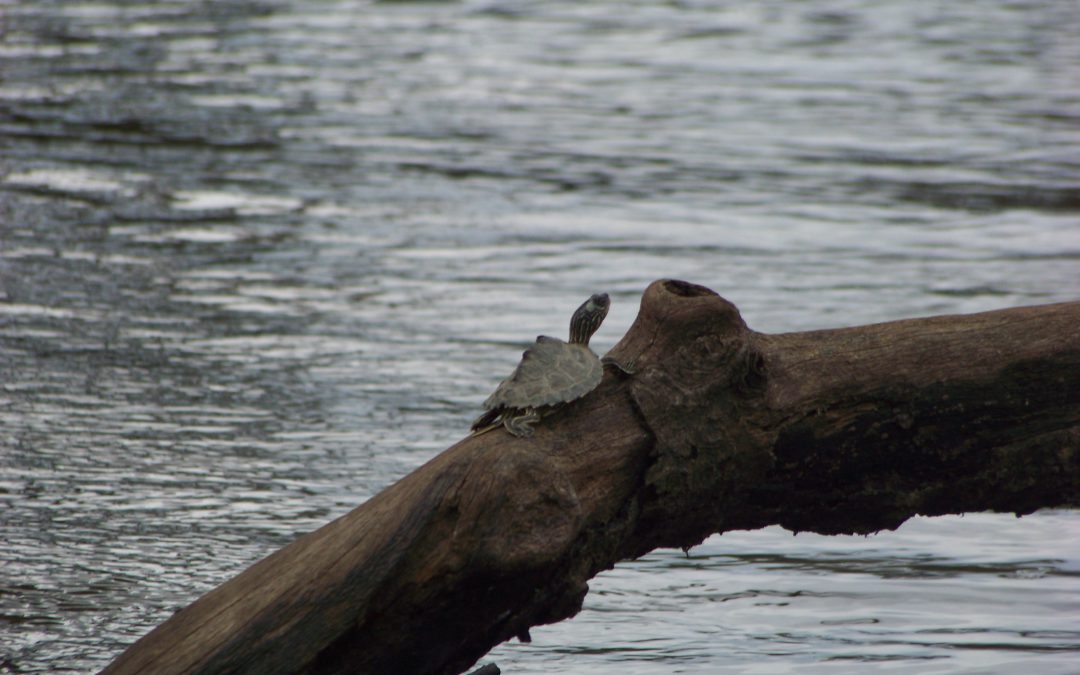
by Rick O'Connor | May 3, 2020
Map turtles (Graptemys) are pretty common across much of the eastern and midwest areas of the United States. Not so much in Florida. There are only two species, and they are only found in the panhandle. However, the range for those two species is mostly in Florida making them a unique Florida turtle, and ones that both the state and federal agencies monitor for occurrence.
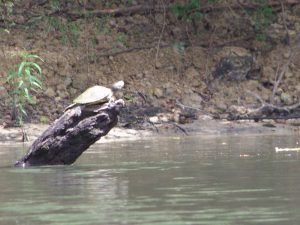
The Barbour’s Map Turtle sitting on a tree stump in the Chiploa River.
Photo: Molly O’Connor
In the 1940s and 50s it was believed that the Barbour’s Map Turtle (Graptemys barbouri) was only found in the Apalachicola River and the Escambia Map Turtle (Graptemys ernsti) was only found in the Escambia. As a matter of fact, with much of the Escambia River actually in Alabama, they were not sure whether the Escambia Map Turtle was different from the Alabama Map Turtle ( Graptemys pulchra) that inhabits the upper reaches of the Escambia River in Alabama, where they call it the Conecuh River.
Today they do now consider it a separate species and they also know these turtles are found in other rivers in the panhandle. As a matter of fact, there may be more Barbour’s Map Turtles in the Chipola River than in the Apalachicola.
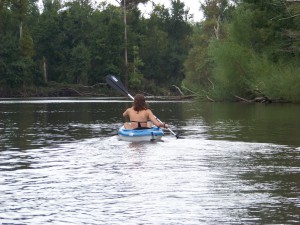
Paddling the Escambia River.
Photo: Molly O’Connor
This is definitely a river turtle – preferring stronger currents with plenty of fallen trees (snags) to bask on – something they like to do a lot of. The females are twice as large as the males, with very wide heads and powerful jaws for crushing mollusk shells – their favorite food. Males are much smaller and feed primarily on insects and other aquatic invertebrates. Because of their preference for mollusk, they are usually not found in tannic rivers, like Blackwater or Perdido Rivers, where the pH is to low for successful shell development. And even on the more alluvial rivers, they are not common in the quiet backwater areas of the floodplain swamps – they really like the currents where the mollusk are.
The Barbour’s Map Turtle differs from the Escambia Map in that (a) they have circular yellow patterns on each scute (scale) of the olive green to brown carapace (top shell), (b) lack the two large yellow spots on the top of the head, behind the eye that you find in the Escambia Map, (c) lack the dark black stripe running down the middle keel of the carapace you find in the Escambia Map, (d) the rivers they inhabit.
Barbour’s Map Turtles are found in the rivers between (and including) the Choctawhatchee River and the Apalachicola River. There have been records of Barbour’s Map Turtle in the Ochlockoknee River, but it is believed they may have been moved there by humans.
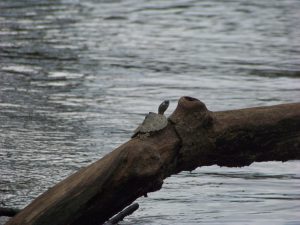
The Escambia Map Turtle is only found in the Escambia, Yellow, and Shoal Rivers.
Photo: Molly O’Connor
The Escambia Map Turtle is found in rivers that feed into Pensacola Bay. These would include the Escambia, Yellow, and Shoal Rivers – again, Blackwater is too tannic. There is discussion whether the Escambia Map has been found in the Choctawhatchee, and there may be some hybridization occurring here.
On rivers where they are found, map turtles can be some of the most common turtles seen. They have high domes shells, that look more “inflated” towards the head end, and scales that form jagged points sticking up along the mid-line of the shell. This gives them a “dinosaur” appearance and another common name “sawbacks”. They are not big turtles, when compared to others like softshell, cooters, snappers – reaching a maximum shell length of 12 inches – are often seen basking on fallen trees (snags) in the water. They are skittish and hard to get close to. Many will jump into the water when you are still over 300 feet away. But for those patient enough to drift, you should get a closer look, and maybe even a picture. On one paddle I did on the Escambia River they made up over 75% of the turtles we saw in a one-mile stretch.
The Barbour’s Map prefers sections of the river where the current is strong and limestone outcrops are frequent. These limestone sections are home to a variety of snail species – the female’s favorite food. Like so many other turtles, they do have to have sandy beaches for nesting. They will venture downstream to find these where the river makes sharp turns and may venture as far as 350 feet inland looking for a suitable nesting spot. Here raccoons do their damage. They not only consume the eggs but will prey on the adults as well. It is also known that occasionally bald eagles will target map turtles as food.
Times are harder for the Barbour’s Map Turtle. In the 1950s there were reports of as many as 136 map turtles / mile. Today the numbers are more like 5-10. The decline can be attributed to several issues.
1) Human harvest. Though not as frequent today, there are records of human harvesting within their range, particularly in the Chipola River area.
2) Dams. Altering the river flow and available “snags” has impacted their numbers.
3) Removing “snags”. This is done for both navigation issues with boaters and because there are unsightly to some. However, map turtles need them – as do other riverine wildlife.
4) “Plinking”. This is a “sport” that is not as common as it once was, but still happens. This is when humans use basking turtles as target practice.
All of these, and probably others, have contributed to this decline and forced the state to protect them. They are now listed on Florida’s Imperiled Species List and you are not allowed to possess them.
The Escambia Map Turtle is still very common on the Escambia River. However, all the members of this species only live on three short rivers, and Florida is concerned that they numbers could be wiped out with a catastrophic event.
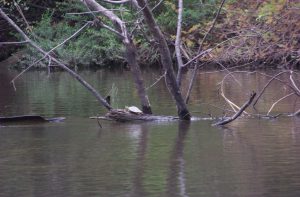
An Escambia Map Turtle in a more quiet portion of the river.
Photo: Molly O’Connor
This portion of Florida lacks the limestone substrate you find further east. The Escambia River was home to one of the greatest variety of mussels in the Florida rivers. This is their choice of food over snails. However, pollution from agriculture and a paper mill in the Alabama portion of the river, as well as altered flow and sediments due to dams in the Alabama portion, have caused a decline in the mussels. Interestingly, the non-native Asian Clam was accidentally introduced to all the river systems in the panhandle, and the map turtles love them. Some believe the introduction of the Asian Clam may have “saved” the Escambia Map.
In addition to the stressors mentioned with the Barbour’s Map, the Escambia Map has had problems with local ATVs riding all over their nesting beaches destroying nests. Because of their small geographic range, and the increase in potential threats, Florida prohibits the possession of this map turtle as well.
The cool thing about these map turtles is that they are only found in a small area of the planet – in our north Florida rivers. I hope we can protect them, and that you get to see some one day.























